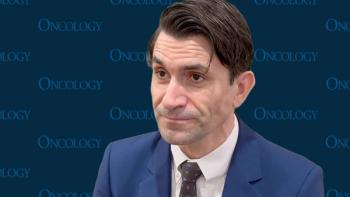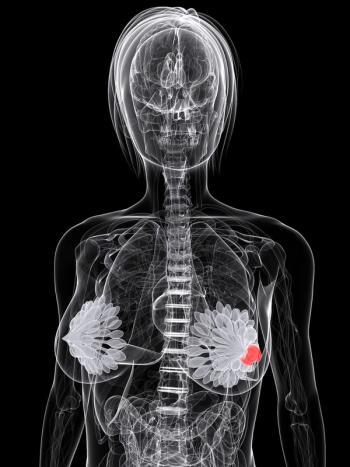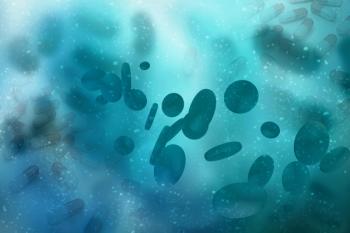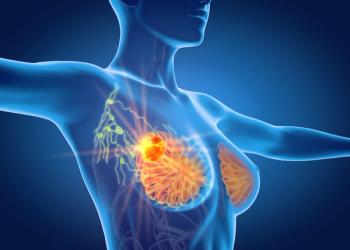
Busulfan-Enhanced VRd Regimen Improves Efficacy in NDMM
Busulfan/melphalan elicited higher PFS among patients with ISS stage II or stage III disease, and melphalan-200 improved PFS in ISS stage I disease.
Busulfan plus melphalan (BUMEL) as a myeloablative therapy elicited enhanced efficacy in patients with newly diagnosed multiple myeloma (NDMM) vs melphalan alone (Alkeran) when used with the triplet regimen comprised of bortezomib (Velcade), lenalidomide (Revlimid), and dexamethasone (VRd) plus lenalidomide-based maintenance therapy, according to findings from the phase 3 GEM2012MENOS65 trial (NCT01916252) published in Blood.
Efficacy data from the trial revealed that following induction therapy, the conventional response (CR) or better rate among patients treated in the BUMEL arm vs the melphalan mg/m2 (MEL-200) arm was 42.2% vs 30.3% (OR, 1.68; 95% CI, 1.14-2.47). After autologous stem cell transplantation (ASCT), the respective rates were 53.5% and 43.0% (OR, 1.52; 95% CI, 1.05-2.20). Following consolidation therapy, the rates were 59.1% and 53.1% (OR, 1.28; 95% CI, 0.88-1.85).
Additionally, the median progression-free survival (PFS) between the BUMEL and MEL-200 arms was 89.0 months vs 73.1 months, the difference of which was not statistically significant (HR, 0.89; 95% CI, 0.70-1.14; P = .3). The 9-year overall survival (OS) rate between each group was 67.3% vs 64.9%, with an HR comparison for death of 0.96 (95% CI, 0.69-1.33; P = .8).
The most common cause for mortality in the respective arms was disease progression, with 33 patients in the BUMEL arm vs 42 patients in the MEL-200 arm experiencing progression-related mortality, followed by infectious complications (20 vs 15) and second primary neoplasms (4 vs 4). There were no significant differences in causes of mortality between the 2 treatment groups.
Additionally, adjusted OS and PFS analyses for International Staging System (ISS) staging and cytogenetic features revealed that BUMEL was associated with a greater median PFS in patients with ISS stage II or III disease, with a median PFS of 76 months (95% CI, 54-108) vs 57 months with MEL-200. Patients with ISS stage I disease saw enhanced PFS outcomes with MEL-200.
“Although in the present randomized study, the HR estimate for progression or death between BUMEL and MEL-200 was not conclusive, with median PFS of 89.0 vs 73.1 months, respectively, the same was not true for the minimal residual disease [MRD]–negative rate: 68% with BUMEL compared with 58% with MEL-200, a statistically significant difference, which is a well-established criterion of effectiveness in accordance with the consensus reached at the FDA/ODAC [Oncologic Drugs Advisory Committee] hearing,” Juan José Lahuerta, PhD, hematologist at Instituto de Investigación Hospital Universitario 12 de Octubre in Madrid, Spain, wrote in the publication with study coinvestigators. “On the other hand, we cannot exclude that the intensified 8 VRd cycles might have blunted a potential beneficial effect of BUMEL compared with MEL-200.”
ASCT-eligible patients 65 years or younger with NDMM (n = 458) were randomly assigned to receive BUMEL (n = 230) or MEL-200 (n = 228) plus reinforced VRd at induction and consolidation. Those enrolled were randomly assigned in a 2 x 2 design with a 1:1:1:1 allocation ratio to ensure appropriate balance with subsequent maintenance therapy.
Initially, patients received induction with 1.3 mg/m2 of subcutaneous bortezomib on days 1, 4, 8, and 11; 25 mg of daily lenalidomide on days 1 to 21; and 40 mg of dexamethasone on days 1 to 4 and 9 to 12 of six 4-week cycles. Mobilization was initiated at the third cycle in the absence of progression or unacceptable toxicity.
Patients received 3.2 mg/kg of intravenous busulfan plus 140 mg/m2 of melphalan on days –5 to –3 of treatment or 200 mg/m2 of melphalan for ASCT conditioning. Two subsequent VRd cycles were given at 3 months after ASCT.
In the BUMEL and MEL-200 arms, the median age was 58.3 years (IQR, 53-62) vs 58.0 years (IQR, 51-62) and 54.8% vs 50.0% of patients were male. In total, 40.9% vs 44.3% and 40.9% vs 38.6% had an ECOG performance status of 0 or 1, respectively, and 57.4% vs 61.8% had IgG disease. Most patients had ISS stage I (42.2% vs 34.6%) or ISS stage II (36.5% vs 40.8%) disease, 1q21 abnormalities (33.9% vs 33.8%), and a standard-risk cytogenetic profile (64.4% vs 66.7%).
The primary end point of the study was PFS. Secondary end points included OS, MRD status, CR rate defined as the incidence of very good partial responses or better, and safety.
The most common grade 3 or higher treatment-emergent adverse effects (AEs) included neutropenia (12.9%) and infection (9.2%), with grade 2 or higher neuropathy occurring during induction in 17.0% of patients. The incidence of organ toxicity associated with high-dose therapy or ASCT was 39% in the BUMEL arm and 49% in the MEL-200 arm. The most common AEs included stomatitis, gastrointestinal toxicity, infections, and hepatotoxicity. Of note, 2 infection-related deaths occurred by day 100 in the BUMEL group.
Reference
Lahuerta JJ, San-Miguel J, Jiménez-Ubieto A, et al. High-dose busulfan-melphalan vs. melphalan and reinforced VRD in newly diagnosed multiple myeloma: a phase III GEM trial. Blood. Published online June 11, 2025. doi:10.1182/blood.2025028313
Newsletter
Stay up to date on recent advances in the multidisciplinary approach to cancer.
















































































